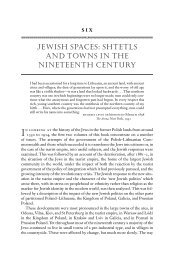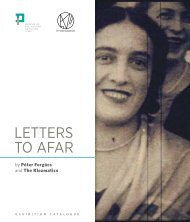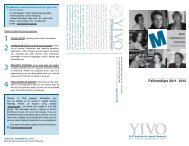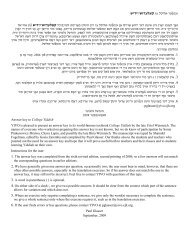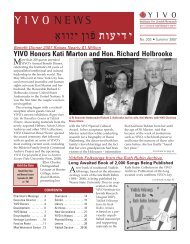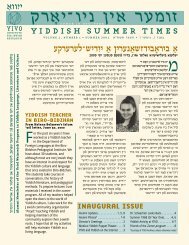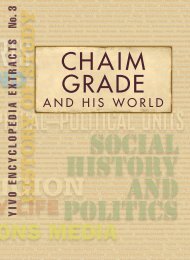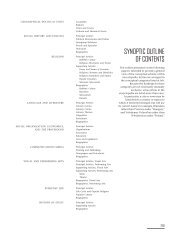Create successful ePaper yourself
Turn your PDF publications into a flip-book with our unique Google optimized e-Paper software.
ish émigrés, however, Hungary’s newly<br />
restrictive laws, implemented in 1938,<br />
prevented Jews—highly represented as<br />
filmmakers—from working. These included<br />
the industry’s three leading directors,<br />
István Székely, Béla Gaál, and Viktor<br />
Gertler, as well as the popular comedian<br />
Gyula Kabos, whose character humor was<br />
understood as typically Jewish.<br />
Post–World War II Period<br />
Yiddish-language cinema, which depended<br />
on two markets—one in America,<br />
the other in Poland—was dealt a serious<br />
blow by the outbreak of World War II and<br />
a fatal one by the murder of Polish Jewry.<br />
Nevertheless, beginning in 1946, Shaul<br />
Goskind produced a series of Yiddish<br />
newsreels on postwar Jewish life. According<br />
to Goskind’s director Natan Gross,<br />
these short documentaries, screened as<br />
special shows attended almost entirely by<br />
Jews, were the first films made in Poland<br />
after the war.<br />
In 1947 and 1948, Gross and Goskind<br />
made two ambitious features, Mir lebngeblibene<br />
(We the Living Remnant) and<br />
Undzere kinder (Our Children). Neither<br />
would be shown in Poland although two<br />
movies released in 1948 did address the<br />
fate of Polish Jewry: Wanda Jakubowska’s<br />
Ostatni etap (The Last Stage; 1948) based<br />
on her own experiences in Auschwitz,<br />
and Aleksander Ford’s Ulica graniczna<br />
(Border Street; 1948). Ulica graniczna,<br />
which has as its climax the Warsaw<br />
ghetto uprising, was held for release for<br />
over a year; so was the most notable<br />
Czechoslovakian representation of the<br />
Holocaust, Alfred Radok’s 1948 Daleká<br />
cesta (Distant Journey), which focuses on<br />
a Jewish doctor who briefly forestalls her<br />
deportation to Terezín by marrying a gentile<br />
colleague. These films were victims of<br />
the upsurge of government antisemitism<br />
within the Soviet Union. Among Soviet<br />
directors, Trauberg and Vertov were particular<br />
targets of the anticosmopolitan<br />
campaign of the late 1940s and early<br />
1950s, as was Sergei Iuktevich who, like<br />
Eisenstein, was identified as a Jew. (Eisenstein<br />
was under attack when he died in<br />
1948.) The cosmopolitans were accused<br />
of promoting an international cinema<br />
culture and of “groveling” before Western<br />
films. Virtually all Jewish directors were<br />
stigmatized; some, including Kozintsev,<br />
Romm, and Room, compensated by making<br />
egregiously conformist and anti-<br />
Western movies.<br />
Jewish themes were slow to reemerge<br />
on the Soviet screen. In 1966, Mikhail<br />
Kulik struggled in vain to make a movie<br />
334 CINEMA<br />
about the Vilna Ghetto. Aleksandr<br />
Askol’dov’s 1967 Kommisar, which drew<br />
on Jewish authors Isaac Babel and Vasilii<br />
Grossman as well as the shtetl films of the<br />
1920s, was banned for more than two decades.<br />
While many of the leading Polish directors<br />
of the 1950s were Jews—Ford, Jerzy<br />
Hoffman, Janusz Morgenstern, Andrzej<br />
Munk, and Roman Polanski among<br />
them—few movies featured Jewish protagonists.<br />
The two exceptions were both<br />
lavish period pieces, Wojciech Has’s 1974<br />
adaptation of Bruno Schultz’s Sanatorium<br />
pod klepsydra (Sanatorium under the<br />
Hourglass) and Jerzy Kawalerowicz’s 1981<br />
Austeria. Andrzej Wajda, a gentile, was<br />
the only major Polish director to consistently<br />
represent Polish Jews, notably<br />
in his Warsaw ghetto dramas, Samson<br />
(1961), Korczak (1990), and Wielki tydzien<br />
(Holy Week; 1995).<br />
In the mid-1960s, Daleká cesta was rediscovered<br />
by the Czech “new wave” and<br />
the persecution of Czech Jews used as a<br />
metaphor for the postwar fate of the<br />
Czech nation. After directing Transport z<br />
raje (Transport from Paradise; 1963) from<br />
Arnošt Lustig’s Terezín novel, Zbynõk<br />
Brynych universalized the plight of a Jewish<br />
family under the Nazis in ...a páty<br />
jezdec je Strach (...TheFifth Horseman Is<br />
Fear; 1964). Jan Nõmec’s Démanty noci<br />
(Diamonds of the Night; 1965), based on<br />
Lustig’s story of two Jewish boys who escape<br />
from a transport, similarly aspired to<br />
universalized Jewish themes. The tendency’s<br />
most celebrated example, Obchod<br />
na korze (The Shop on Main Street; 1965)<br />
by Jan Kadár and Elmar Klos, starring Ida<br />
Kaminska, won an Academy Award for<br />
best foreign feature; further instances are<br />
Antonin Moskalyk’s 1967 adaptation of<br />
Lustig’s Dita Saxová and Juraj Herz’s<br />
Spalovaó mrtvol (The Cremator of Corpses;<br />
1968). As if to validate their larger antitotalitarian<br />
readings, all of these were<br />
shelved and/or vilified in Czechoslovakia<br />
after the 1968 Warsaw Pact invasion.<br />
Unlike Poland or Czechoslovakia, Hungary<br />
produced no postwar representation<br />
of Jewish wartime suffering, although the<br />
fate of Hungarian Jewry was acknowledged<br />
in a number of movies, including<br />
Félix Máriássy’s 1955 Budapesti tavasz<br />
(Springtime in Budapest) and János<br />
Herskó’s 1963 Párbsezéd (Dialogue). A few<br />
discreetly Jewish characters appeared in<br />
the work of István Szabó and Sándor Simó<br />
but Jews were as underrepresented on the<br />
screen as they were prominent behind<br />
the camera. Indeed, the lead in introduc-<br />
ing Jewish subject matter was taken by<br />
gentiles. Miklós Jancsó, whose extended<br />
family included Yiddish-speaking Transylvanian<br />
Jews, made a number of poetic<br />
documentaries meditating on the destruction<br />
of Jewish life in Hungary. Imre<br />
Gyöngyössy and Barna Karbay’s Jób<br />
lázadása (The Revolt of Job; 1983) was the<br />
first Hungarian movie to center on the<br />
wartime deportation of the Jews.<br />
After Communism<br />
Beginning in the mid-1980s and gaining<br />
momentum with the dissolution of<br />
Communism, Jews repopulated the East<br />
European cinema, albeit almost entirely<br />
as historical figures. Juraj Herz, who<br />
had been deported to Ravensbruck as a<br />
child, directed a second Holocaust feature<br />
Zastihla mì noc (Night Caught Up<br />
with Me; 1986). Veteran filmmaker Karel<br />
Kachyûa made three pictures on the history<br />
of Czech Jews: Smrt krásnych srncï<br />
(The Death of the Beautiful Roebuck;<br />
1986), based on the autobiographical novella<br />
by Jewish journalist Ota Pavel;<br />
Poslední motýl (The Last Butterfly; 1990),<br />
about Jewish children in Terezín; and<br />
Hanele (1999), adapted from the novella<br />
by Ivan Olbracht. The drama of sheltering<br />
a Jew during the Nazi occupation, a<br />
theme previously treated in Budapesti<br />
tavasz and by Czech director Ji֒ Weiss in<br />
his Romeo, Julie a tma (Romeo, Juliet and<br />
Darkness; 1959), returned in Wajda’s<br />
Wielki tydzieá, Jan Hrebejk’s Musíme si<br />
pomahat (Divided We Fall; 2000), and Jan-<br />
Jakub Kolski’s Daleko od okna (Far from<br />
the Window; 2000).<br />
In Hungary, a late twentieth-century resurgence<br />
of Jewish subject matter was<br />
largely associated with Jewish filmmakers.<br />
Gyula Gazdag’s 1985 Auschwitz<br />
documentary Társasutszás (Package Tour)<br />
was followed by Tutajosok (Memoirs of<br />
a River; 1989), in which Judit Elek addressed<br />
the taboo subject of the Tiszaeszlár<br />
trial. Andras Jeles dramatized<br />
the Jewish deportations in Senkiföldje<br />
(Why Wasn’t He There; 1993); Herskó returned<br />
to Hungary in 1995 to make the<br />
documentary A Kenyereslány Balladája<br />
(The Ballad of the Bread Girl), in which<br />
he revisited the sites where he had been<br />
sent as a Jewish slave-laborer. A related<br />
trend involves the reworking of amateur<br />
16mm movies shot by Hungarian Jews<br />
in the 1930s and 1940s, most notably in<br />
the movies made by video artist Pétér<br />
Forgacs.<br />
The dissolution of the Soviet Union<br />
brought a brief flurry of adaptations from<br />
Babel and Sholem Aleichem—three ver-<br />
MS3<br />
S<br />
R<br />
L



